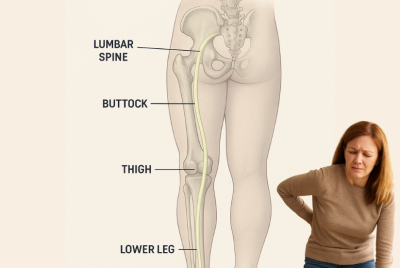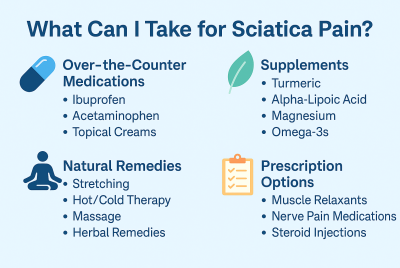Top 10 Foods to Avoid If You Have Sciatica
Reduce Inflammation and Support Nerve Health with Smarter Nutrition
If you’re dealing with sciatica, you already know how painful and limiting it can be. But did you know your diet could be making it worse? While stretching, posture, and exercise are all important for managing sciatica, what you eat also plays a major role in inflammation, a key driver of sciatic nerve pain. So what foods to avoid with sciatica?
In this guide, we’ll explore the connection between diet and nerve inflammation, uncover the top 10 foods to avoid if you have sciatica, and offer simple food swaps and supplement tips to support your healing.
🧠 The Diet–Inflammation Link
Sciatica usually occurs when the sciatic nerve is compressed or irritated, often by a herniated disc, spinal misalignment, or tight muscles. But underlying inflammation amplifies the pain and slows healing.
Certain foods are known to increase systemic inflammation, which can worsen nerve pain, reduce mobility, and prolong recovery.
On the other hand, an anti-inflammatory diet can:
-
Reduce pressure on the nerve
-
Improve circulation
-
Support tissue repair
-
Ease overall pain and stiffness
The bottom line? What you eat can either fuel the fire or calm it down.
🚫 Top 10 Foods to Avoid If You Have Sciatica
Here are the top inflammation-triggering foods that sciatica sufferers should try to avoid, or at least reduce significantly:
1. Refined Sugar
Excess sugar spikes blood glucose, promotes insulin resistance, and triggers inflammation throughout the body.
🔻 Common culprits:
-
Soda
-
Candy
-
Baked goods
-
Sugary cereals
2. Processed Meats
Sausages, bacon, hot dogs, and deli meats are full of preservatives, sodium, and inflammatory fats that can irritate your system.
3. Fried Foods
Foods fried in trans fats or seed oils (like vegetable or soybean oil) promote oxidative stress and nerve irritation.
🔻 Includes:
-
French fries
-
Fried chicken
-
Onion rings
4. Refined Carbohydrates
White bread, pasta, and rice quickly convert to sugar, causing inflammation and energy crashes.
5. Dairy (For Some People)
Dairy can be inflammatory, especially in those with lactose intolerance or sensitivity to casein proteins.
🔻 Watch for:
-
Cheese
-
Milk
-
Cream-based sauces
6. Alcohol
Alcohol impairs liver function, dehydrates tissues, and disrupts sleep, all of which can worsen pain.
7. Excess Caffeine
A little coffee may be okay, but too much can stimulate the nervous system and contribute to muscle tightness and increased pain sensitivity.
8. Artificial Additives
Colorings, flavorings, and preservatives (like MSG or aspartame) can trigger inflammatory responses in sensitive individuals.
9. Red Meat (in excess)
Fatty cuts of beef or lamb are high in saturated fats, which may contribute to inflammation if eaten frequently.
10. Gluten (for sensitive individuals)
People with gluten sensitivity or autoimmune conditions may experience more inflammation from gluten-containing foods like bread, pasta, and pastries.
✅ Healthier Food Swaps
You don’t have to give up flavor or satisfaction to eat anti-inflammatory. Here are simple swaps that support sciatic nerve healing:
| Inflammatory Food | Healthy Swap |
|---|---|
| White bread | Sprouted grain or gluten-free bread |
| Soda | Sparkling water with lemon or herbal tea |
| Processed meat | Grilled chicken, wild-caught fish, or legumes |
| Candy | Dark chocolate (70%+ cocoa) or fruit |
| Creamy dressings | Olive oil with balsamic vinegar or avocado-based dressings |
| Fries | Baked sweet potato wedges |
| Ice cream | Coconut milk or banana-based frozen treats |
These choices can reduce inflammation, stabilize blood sugar, and provide your body with the nutrients it needs to recover.
7 Foods to Improve and 5 Foods to Avoid with Sciatica
🍽 Sample Anti-Inflammatory Meal Plan
Here’s a simple day of eating designed to reduce sciatica-related inflammation and support healing:
🥣 Breakfast
-
Oatmeal topped with berries, chia seeds, and walnuts
-
Green tea or warm lemon water
🥗 Lunch
-
Grilled salmon salad with mixed greens, avocado, olive oil, and lemon
-
A handful of almonds
🍲 Dinner
-
Quinoa with steamed broccoli and turmeric-roasted chicken
-
Herbal tea with ginger or chamomile
🥤 Snacks
-
Apple slices with almond butter
-
Hummus with sliced veggies
This meal plan is rich in omega-3s, antioxidants, fiber, and plant-based nutrients—all crucial for calming the body’s inflammatory response.
💊 Supplements That May Help
In addition to a clean, anti-inflammatory diet, certain supplements may help relieve sciatica symptoms naturally:
1. Turmeric (Curcumin)
A natural anti-inflammatory that helps reduce nerve pain and swelling.
2. Magnesium
Supports nerve function and helps relax muscles around the sciatic nerve.
3. Omega-3 Fatty Acids
Found in fish oil or flaxseed oil, these reduce systemic inflammation and support joint health.
4. Vitamin B12
Crucial for nerve repair and function, especially if you’re a vegetarian or older.
5. Alpha Lipoic Acid
An antioxidant that may improve nerve pain and reduce oxidative stress.
✅ Always check with your healthcare provider before starting new supplements, especially if you’re taking medications.
❓ FAQs About Foods to Avoid with Sciatica
1. Can food really make sciatica worse?
Yes. Inflammatory foods can increase pressure around the nerve by promoting water retention, tissue swelling, and poor circulation.
2. What’s the #1 food to avoid?
Refined sugar is a major culprit—it fuels inflammation and can worsen nerve sensitivity.
3. Is coffee bad for sciatica?
In moderation, no. But too much caffeine can overstimulate your nervous system and interfere with healing.
4. Does drinking more water help sciatica?
Yes. Staying hydrated keeps spinal discs and muscles healthy and aids in flushing out inflammatory toxins.
5. Are anti-inflammatory diets safe long-term?
Absolutely. Diets rich in whole foods, healthy fats, and antioxidants are beneficial not just for sciatica but for overall wellness.
🧠 Final Thoughts on Foods to Avoid with Sciatica
Managing sciatica pain isn’t just about stretching and posture—it also begins at the dinner table. By avoiding the top inflammation-triggering foods and fueling your body with nutrient-rich options, you can support faster healing and long-term pain relief. Add in smart supplements, hydration, and regular movement, and you’ll be giving your sciatic nerve the best chance at recovery.
Small dietary changes can lead to big relief—one meal at a time.
Please note that this article should not replace professional medical advice. Consult a healthcare professional for an accurate diagnosis and tailored treatment plan.
👉 Next Reads:





